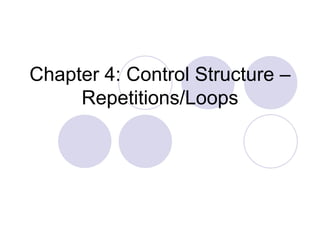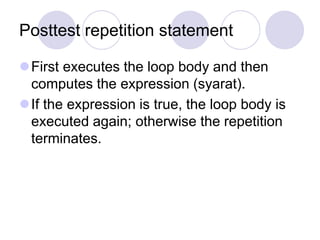Looping
- 1. Chapter 4: Control Structure â Repetitions/Loops
- 2. Objectives ïŽState the types of repetitions ïŽDifferentiate among three types of repetitions ïŽBuild a simple program to solve a problem using repetitions ïŽ
- 3. pretest Repetitions structure ïŽ The expression (syarat) is evaluated, before the loop body is executed. ïŽ If the result of evaluation is true. the loop body is executed. Following this, control goes back to the expression and is evaluated again. This continues until the expression computes to a value of false. ïŽ If the expression produce of false, the loop body is bypassed and the program control drops down to the statement.
- 6. Posttest repetition statement ïŽFirst executes the loop body and then computes the expression (syarat). ïŽIf the expression is true, the loop body is executed again; otherwise the repetition terminates.
- 9. Repetitions with counter value (nilai pembilang) Nilai Pembilang Hasil dari pelaksanaan arahan nilai pembilang i++ Nilai pembilang iaitu i ditambah dengan satu i-- Nilai pembilang i dikurangkan dengan satu i+=2 Nilai pembilang i ditambah dengan 2 i*=2 Nilai pembilang i didarab dengan 2
- 10. While loop ïŽ #include<iostream.h> ïŽ main() ïŽ { ïŽ int i=0; ïŽ while ( i <= 5 ) ïŽ { ïŽ cout<<"n Welcome to while statement"; ïŽ i++; ïŽ } ïŽ }
- 11. do â while loop ïŽ #include<iostream.h> ïŽ main() ïŽ { ïŽ int i=0; ïŽ do { ïŽ cout<<"n Welcome to while statement"; ïŽ i++; ïŽ } while ( i <=5); ïŽ }
- 12. For loop ïŽ#include<iostream.h> ïŽmain() ïŽ{ ïŽ int i; ïŽ for (i=0; i<=5; i++) ïŽ cout<<"n Welcome to while statement"; ïŽ}
- 13. For loops with counter ïŽ Sintaksis: ïŽ for (pembolehubah = nilai_awalan; syarat; pembilang) ïŽ Blok arahan ïŽ { senarai penyataan; ïŽ : ïŽ : ïŽ ïŽ }
- 14. Loops with sentinel value we donât know the number of loops will execute. For example, we donât know how many items bought by customer. Refer to Rajah 4.8 page# 62
- 15. Nested Loop ïŽIn a nested loop, one loop referred to as the inner loop and one is called the outer loop.















